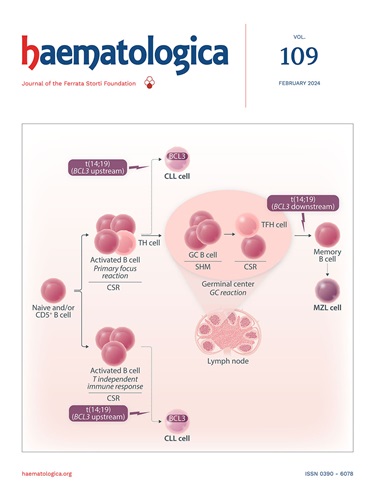抗hla I类IgG亚类在输血难治性中扭曲血小板激活机制。
IF 7.9
1区 医学
Q1 HEMATOLOGY
引用次数: 0
摘要
需要反复输注血小板的患者容易出现血小板输注难治性(PTR),这是由于输注血小板从循环中迅速清除而导致的治疗失败。PTR的一个主要原因是受体中存在针对供体血小板表达的同种异体HLA- 1类(HLA- 1)分子的多个IgG。引人注目的是,抗hla - 1 IgG的存在并不一定与PTR相关,从而质疑抗体性质本身的作用。使用hla - 1同种异体免疫患者的血液,有或没有PTR,我们确定其抗hla - 1 IgG的亚类。我们发现这些亚类的分布因患者而异,IgG1在非PTR患者中占主导地位,而在PTR患者中检测到IgG1与IgG2或IgG3的联合。为了了解PTR的相关机制,我们使用了人嵌合泛hla - 1 IgG1、IgG2或IgG3抗体,并评估了这些人IgG亚类对血小板激活的功能影响。我们发现每个亚类都导致血小板聚集、p -选择素暴露和膜联蛋白V结合。然而,我们发现血小板激活的机制在亚类之间存在差异。具体来说,我们发现泛hla -i higg2诱导的血小板活化依赖于CD32a,而hIgG1-和higg3诱导的血小板活化依赖于补体募集。因此,这项研究可能对高度多免疫患者的致病性抗hla - 1同种异体抗体的分级有直接意义,并对选择合适的治疗方法有价值的帮助,特别是通过简化寻找功能相容的血小板成分。本文章由计算机程序翻译,如有差异,请以英文原文为准。
Anti-HLA class I IgG subclasses skew platelet activation mechanisms in transfusion refractoriness.
Patients requiring recurrent platelet transfusions are subject to platelet transfusion refractoriness (PTR), a therapeutic failure due to rapid clearance of transfused platelets from the circulation. One major cause of PTR is the presence in the recipient of multiple IgG directed against allogeneic HLA Class-I (HLA-I) molecules expressed by the donor platelets. Strikingly, the presence of anti-HLA-I IgG does not necessarily correlate with PTR, thus questioning the role of the antibody properties themselves. Using blood of HLA-I alloimmunized patients with or without PTR, we identified the subclasses of their anti-HLA-I IgG. We found the distribution of these subclasses to be different according to patients, with IgG1 being predominant in non-PTR patients while IgG1 in combination with IgG2 or IgG3 were detected in PTR patients. To understand the mechanisms associated with PTR, we used human chimeric pan-HLA-I IgG1, IgG2, or IgG3 antibodies and assessed the functional implications of these human IgG subclasses on platelet activation. We showed that each subclass led to platelet aggregation, P-selectin exposure and Annexin V binding. However, we found that the mechanisms of platelet activation differed between subclasses. Specifically, we discovered that pan-HLA-I hIgG2-induced platelet activation was CD32a dependent, while hIgG1- and hIgG3-induced platelet activation relied on complement recruitment. Hence, this study may have direct implications for hierarchizing pathogenic anti-HLA-I alloantibodies in highly polyimmunized patients and be a valuable aid in selecting suitable treatments, particularly by streamlining the search for functionally compatible platelet components.
求助全文
通过发布文献求助,成功后即可免费获取论文全文。
去求助
来源期刊

Haematologica
医学-血液学
CiteScore
14.10
自引率
2.00%
发文量
349
审稿时长
3-6 weeks
期刊介绍:
Haematologica is a journal that publishes articles within the broad field of hematology. It reports on novel findings in basic, clinical, and translational research.
Scope:
The scope of the journal includes reporting novel research results that:
Have a significant impact on understanding normal hematology or the development of hematological diseases.
Are likely to bring important changes to the diagnosis or treatment of hematological diseases.
 求助内容:
求助内容: 应助结果提醒方式:
应助结果提醒方式:


